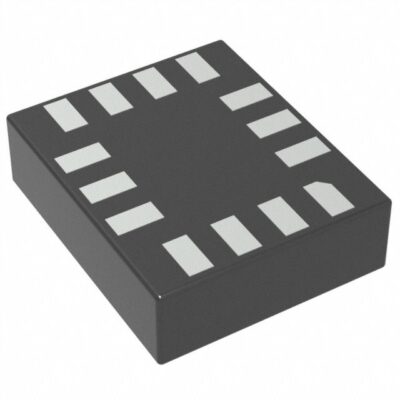LSM6DSMTR
Part Number: LSM6DSMTR
Manufacturer: STMicroelectronics
Description: IMU ACCEL/GYRO I2C/SPI 14LGA
Shipped from: Shenzhen/HK Warehouse
Stock Available: Check with us
ICRFQ.com - Electronic Components Distributor in China Since 2003

Part Number: LSM6DSMTR
Manufacturer: STMicroelectronics
Description: IMU ACCEL/GYRO I2C/SPI 14LGA
Shipped from: Shenzhen/HK Warehouse
Stock Available: Check with us
The LSM6DSM is a system-in-package with a 3D digital accelerometer and gyroscope that work at 0.65 mA in high-performance mode and allow always-on low-power features for the best customer mobility. The LSM6DSM, which has real, virtual, and batch sensors as well as dynamic data batching of up to 4 kbytes, meets the main OS needs. Micromachined accelerometers and gyroscopes are used to make ST’s MEMS sensor modules, which are reliable and well-known methods.
The many sensing parts are made with specialized micromachining techniques, while the IC connections are built with CMOS technology to make a custom circuit that fits the properties of each sensing element. The LSM6DSM has a full-scale acceleration range of 2, 4, 8, and 16 g and a range of angle rates of 125, 250, 500, 1000, and 2000 dps.
The LSM6DSM can be used for both EIS and OIS applications. It has a separate channel for processing OIS signals and an extra SPI port that can be programmed for the gyroscope and accelerometer. Because it can handle mechanical shocks, system designers use the LSM6DSM to make goods that are reliable. The LSM6DSM comes in a plastic LGA package.
The LSM6DSM system-in-package has digital 3-axis accelerometers and gyroscopes that work very well. In high-performance mode, the integrated power-efficient modes lower power consumption to 0.65 mA, combining always-on low-power features with more accurate sensing for the best motion experience. The LSM6DSM has the best motion sensing in its class, which lets app makers and users use more advanced features and functions than just portrait and landscape mode.
Event-detection interruptions hardware-recognize 6D orientation, free-fall events, click and double-click sensing, activity or inaction, and wakeup events for efficient and reliable motion tracking and context awareness. With real, virtual, and batch mode sensors, the LSM6DSM meets the main OS needs. The LSM6DSM can handle Android’s sensor-related functions quickly, which saves battery and speeds up response time. The LSM6DSM can handle a lot of movement, tilt, pedometer functions, timestamping, and collecting data from an external magnetometer with hard and soft ironing corrections.
The LSM6DSM can connect pins with different mode links to external sensors to add more functions, such as a sensor hub, auxiliary SPI, etc. Power is saved by putting important data (from external devices, timestamps, etc.) in up to 4 kbytes of FIFO. The LSM6DSM’s gyroscope and accelerometer devices make it possible to use OIS and EIS. The device sends out OIS data through a specialized OIS signal processing channel and an extra SPI. Data from the OIS can be directly used by application developers.
The signal processing path for the gyroscope UI is FIFO-readable and separate from the OIS. MEMS sensor modules are made with the LSM6DSM in the same way that micromachined accelerometers and gyroscopes are.
CMOS technology is used to make the IC interface into a specific circuit that fits the characteristics of the sensing element. Micromachining techniques are used to make the sensing parts. The LSM6DSM’s 2.5 x 3.0 x 0.83 mm plastic LGA package can be used for very small solutions.
When using the LSM6DSMTR sensor in a project, it’s important to know about the following issues and things to think about:
Follow these suggestions for PCB construction and sensor placement to get the most out of the LSM6DSMTR sensor:
Use the following power management methods to improve sensor performance and extend battery life:
In conclusion, the LSM6DSMTR sensor has a powerful mix of accelerometer, gyroscope, and temperature sensor functions that make it useful for a wide range of applications. Developers can improve the performance and accuracy of the sensor by solving implementation challenges and following best practices for PCB layout, sensor placement, power management, and calibration.
The LSM6DSMTR sensor is useful for projects that involve tracking motion, detecting orientation, and monitoring the surroundings because it is flexible and easy to integrate. We encourage readers to find out what the monitor can do and try it out, using its features to make their projects better.
For more information and resources, check out the datasheet and application notes from the sensor maker, join online communities and forums, and look at reference designs, libraries, and tutorials. Keep up with the latest documents to make sure you have the most useful information for integrating the LSM6DSMTR sensor.
Unlock the LSM6DSMTR sensor’s potential and enjoy putting its features to use in your projects.
Use the LSM6DSMTR to give your ideas more control over how much power they use. Contact ICRFQ right away to learn more and place your order.
https://youtu.be/IaS–Mlm1uY
WhatsApp us